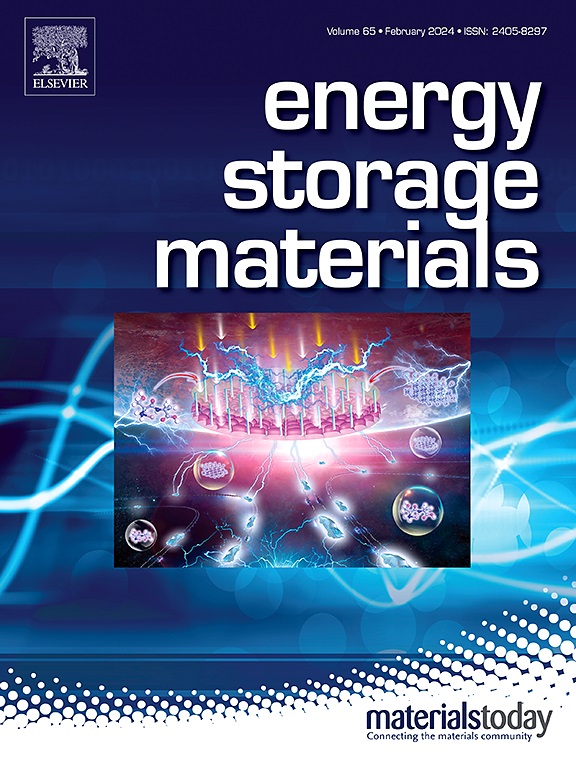局部电场使阴极活性材料在环境条件下快速和准干回收
IF 20.2
1区 材料科学
Q1 CHEMISTRY, PHYSICAL
引用次数: 0
摘要
随着锂离子电池越来越多地用于电力和能量存储,迫切需要关注有效的回收利用,以解决材料供应和环境问题。传统的热法和湿法冶金方法具有破坏性和高能耗,对于像LiFePO4这样广泛使用的阴极来说尤其成问题。在这里,我们介绍了一种快速(<1 s)和准干燥的方法,用于在环境条件下回收活性阴极材料,最大限度地减少能源和水的消耗。对湿润的LiFePO4薄膜(~ 80 μm vs LFP层)施加电场(~ 20 V)会产生一个强大的局部场(~ 105 V/m),该场驱动铝箔界面处的瞬时局部水分裂,产生H2气泡并促进有效的阴极材料分离。温和的条件和超短的反应时间不仅最大限度地减少了对正极材料的影响(减少了20倍的Al杂质和可忽略的结构损坏),而且还简化了再生,潜在地保持了LiFePO4废料的电化学性能,而无需再生。与传统的热法和水力法的对比分析表明,我们的方法具有卓越的能源效率、最小的废水排放和更高的盈利能力,为各种阴极化学和电池废料的连续卷对卷回收提供了一种通用策略。本文章由计算机程序翻译,如有差异,请以英文原文为准。
Localized electric field enabling rapid and quasi-dry recycling of cathode active materials at ambient condition
Amidst the increasing use of Li-ion batteries for power and energy storage, urgent attention is needed for effective recycling to address material supply and environmental concerns. Traditional pyro- and hydro-metallurgical methods, known for destructiveness and high energy consumption, are particularly problematic for widely used cathodes like LiFePO4. Here, we introduce a rapid (<1 s) and quasi-dry method for recycling active cathode materials at ambient conditions, minimizing energy and water consumption. Applying an electrical field (∼20 V) to wetted LiFePO4 films (∼80 μm vs LFP layer) produces a robust localized field (∼105 V/m) that drives instantaneous local water splitting at Al foil interfaces, generating H2 bubbles and facilitating efficient cathode material separation. Mild conditions and an ultra-short reaction time not only minimize the impact on cathode materials (>20 times less in Al impurity and negligible structural damage) but also streamline regeneration, potentially maintaining the electrochemical performance of LiFePO4 scrap comparable to commercial counterparts without the need for regeneration. Comparative analysis with traditional pyro and hydro methods highlights our approach's superior energy efficiency, minimal wastewater emission, and increased profitability, offering a versatile strategy for various cathode chemistries and continuous roll-to-roll recycling of battery scraps.
求助全文
通过发布文献求助,成功后即可免费获取论文全文。
去求助
来源期刊

Energy Storage Materials
Materials Science-General Materials Science
CiteScore
33.00
自引率
5.90%
发文量
652
审稿时长
27 days
期刊介绍:
Energy Storage Materials is a global interdisciplinary journal dedicated to sharing scientific and technological advancements in materials and devices for advanced energy storage and related energy conversion, such as in metal-O2 batteries. The journal features comprehensive research articles, including full papers and short communications, as well as authoritative feature articles and reviews by leading experts in the field.
Energy Storage Materials covers a wide range of topics, including the synthesis, fabrication, structure, properties, performance, and technological applications of energy storage materials. Additionally, the journal explores strategies, policies, and developments in the field of energy storage materials and devices for sustainable energy.
Published papers are selected based on their scientific and technological significance, their ability to provide valuable new knowledge, and their relevance to the international research community.
 求助内容:
求助内容: 应助结果提醒方式:
应助结果提醒方式:


